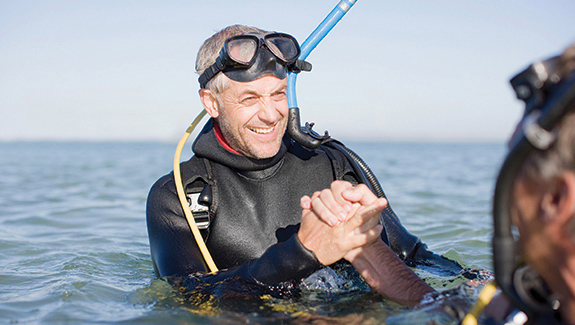Popular Sports Without a Wheelchair
If you have a spinal cord injury and you’re looking to break away from your wheelchair and get moving, here are a few exciting options for you.

Learn about sports that don’t require a wheelchair.
In addition to the wide variety of wheelchair sports you can choose from, there are plenty of activities that don’t involve wheels. Here are some of the most popular non-wheelchair options, including information on equipment, rules, and resources.
Swimming
Swimming is one of the most popular activities not requiring a wheelchair for those with paralysis. It offers a sense of freedom that you can’t get with other forms of exercise. Other key benefits include increased flexibility and strength, and less chance of an injury.
Equipment: All you need are a good pair of goggles and a swimsuit to participate. Pools are required to have disability access equipment.
Rules: For swimming competitions for the physically challenged, The International Swimming Federation makes a few modifications, such as optional platforms or an in-water start.
Get started: Learn more at the International Swimming Federation website. USA Swimming also has great resources to explore, including how to find a local club.
Sledge hockey
Sometimes referred to as “sled hockey,” this sport is comparable to ice hockey. It increases strength and coordination, and is great for conditioning your upper body.
Equipment: Sleds with two-skate blades are used, and players propel themselves using two short hockey sticks with ice picks on the bottoms. Protective hockey gear is required for this action-packed game.
Rules: Teams consist of a goalie, three forwards, and two defensemen. Everyone is classified according to their ability. The ice, goal net, and pucks are all the same as in standard hockey.
Get Started: The Paralympic website is a great resource. If you live in the U.S., you can also visit USA Hockey for more information on sledge hockey.
Downhill skiing
Some of the most advanced technology has been created for those with a spinal cord injury who want to hit the slopes. It’s an exhilarating way to increase coordination and upper body strength.
Equipment: There are different kinds of ski equipment, stabilizers, and poles you can use, depending on your situation. Those with paraplegia and quadriplegia can ski using a sit-ski, mono-ski, or bi-ski.
Rules: If you decide to compete, events vary in modification rules and classifications for each type of competition. All international events are governed by the International Paralympic Committee (IPC).
Get started: Most people ski recreationally, so your local ski resort is a great place to start for equipment fitting and lessons. For information on ski competitions, visit the Paralympic website.
Scuba diving and snorkeling
Scuba diving and snorkeling offer a chance to experience newfound mobility in the underwater world. Your weightlessness in water lets you use muscles you can’t use on land. Plus, diving and snorkeling are partner activities. So, physically-challenged and non-disabled people can work together as a team.
Equipment: All the standard scuba and snorkeling gear are required. Visit your local dive center for help purchasing or renting equipment.
Rules: Disabled Divers International list three Assistance Requirement Levels based on your unique needs. Divers can achieve different levels of certification, from beginner to advanced. There are no snorkeling certifications, but always follow safety tips from your instructor or guide.
Get started: Explore the Disabled Divers International and the Handicapped Scuba Association websites for available resources on both scuba diving and snorkeling.
“Since I dove for the first time today, I was very nervous at first. After a few minutes it became exactly the opposite: my body felt great. The tension and always-present back pains were forgotten. I could forget this physical tension and let go. It was like a beautiful, weightless world.” — A participant in a first amateur diving day
Archery
Although you may choose to enjoy archery in your wheelchair, it doesn’t require the use of it. Archery is a unique blend of mental focus, eye-hand coordination, and muscle control. It’s an invigorating and rewarding sport.
Equipment: Your local archery range has the bows, arrows, and other equipment you need, including rentals if you just want to give it a try.
Rules: For recreation, different types of modifications can be made. For competitions, International Paralympic Committee (IPC) and U.S. Olympic Committee (USOC) guidelines apply.
Get started: Visit your local archery range. For more information, see the international governing body, World Archery. If you’re in the U.S., you can also visit Team USA Archery.
Other popular activities
Many younger people with mobility challenges are trying downhill racing. In this sport, you ride through the countryside in a specially-made mountain bike with four wheels. It’s a combination of downhill mountain biking, rally car racing, and motocross – not for the faint of heart!
Go-karts for people with mobility challenges are also becoming popular. Karting is offered either as an outdoor or an indoor sport. It could be just for fun, or for those with professional racing ambitions. You decide the level you want to achieve with this pulse-pounding sport.
Other popular activities that don’t include wheels are: canoeing, kayaking, horseback riding, sailing, skateboarding, snowboarding, surfing, water skiing, and yoga. Of course, there are many popular wheelchair sports options too.




